- Resources library

Polya’s Problem-Solving Process
Emma Moore, Teaching Excellence Program Master Teacher
Problem-solving skills are crucial for students to navigate challenges, think critically, and find innovative solutions. In PISA, problem-solving competence is defined as “an individual’s capacity to engage in cognitive processing to understand and resolve problem situations where a method of solution is not immediately obvious” (OECD, 2014, p. 30). Returning to the classroom post-COVID, I found that students had lost their ‘grit’ for these deep-thinking tasks. They either struggled to start, gave up easily, or stopped at their first ‘answer’ without considering if it answered the problem or was the only possible solution.
To re-invigorate these skills, I investigated the impact of explicitly teaching Polya's problem-solving process in my Year Six class. This framework developed student agency and supported them to manage their feelings if they felt challenged by the work.
Here, I will share the impact of this initiative and how it empowered students to become effective and resilient problem solvers.
Understanding Polya's Problem-Solving Process
Polya's problem-solving process, developed by mathematician George Polya, provides a structured approach to problem-solving that can be applied across various domains. This four-step process consists of understanding the problem, devising a plan, trying the plan, and revisiting the solution. (Polya, 1947)
In order to focus on the skills and knowledge of the problem-solving process, I began by using tasks where the mathematical processes were obvious. This allowed me to focus on the problem-solving process explicitly.
The question shown in Figure 2 is taken from Peter Sullivan and Pat Lilburn's Open-Ended Maths Activities book. This task was used to establish a baseline assessment for each stage of the process. I planned the prompts in dot points and revealed them one by one through the PowerPoint. After launching the task and giving the students time to think, they recorded all their possible answers in their workbook.
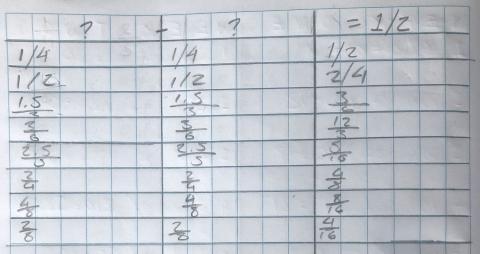
The student sample shown in Figure 3 demonstrates that the student followed a pattern and stuck to it but did not revisit their work. On line two, their response (1 half and 1 half is 2 quarters) is unreasonable.
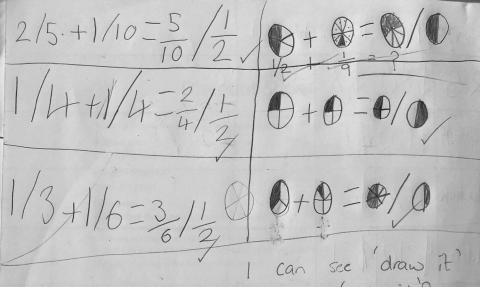
Figure 3 is a sample gathered from a small group of students. This group required support to start. They used paper folding and paper strips to model their thinking.
Over half of the class could give at least one correct answer, but only four students showed signs of checking to see if their plans addressed the problem and yielded correct answers. Understanding the problem and revisiting the solutions became the focus of my inquiry.
The following series of lessons covering operations with fractions and decimals focused on the stages of Polya’s process.
Step 1: Understanding the Problem
The first step of Polya's problem-solving process emphasises the importance of ensuring you thoroughly comprehend the problem. In this step, students learn to read and analyse the problem statement, identify the key information, and clarify any uncertainties. This process encourages critical thinking (Bicer et al., 2020) as students develop the ability to break down complex problems into manageable parts. I facilitated this process by engaging students in discussions and guiding them to identify the essential components of the problem. By fostering a collaborative learning environment, students shared their perspectives and learned to refine their questions when they were unsure. Figure 6 shares an example of a prompt I use for Step 1.
Figure 4: Example prompt for Step 1.
Initially, students who were stuck provided the classic ‘white flag’ responses.
Student: I just don’t get it.
Teacher: What part don’t you get?
Student: All of it!
As a starting point, the students and I co-created a classroom display of helpful questions the students could use to develop their understanding.
These questions supported me to develop a deeper understanding of what students didn’t understand when they expressed uncertainty. This could range from not understanding specific terminology (often easy to explain) to where numbers came from and why their classmates interpreted the problem differently. I found engaging in this step made triaging their misunderstandings easier.
Step 2: Devising a Plan
Once students had grasped the problem, the next step was to formulate a plan of action. In this step, students explored different strategies and selected the most appropriate approach. I prompted students to brainstorm possible solutions, draw diagrams, make tables, and create algorithms, all the time fostering creativity and diverse thinking.
This step had been a strength during the baseline assessment data, and a wide range of strategies were explored. Polya’s strategies were displayed in the classroom as the mathematician’s strategy tool kit, so students were comfortable acknowledging the many ways to solve the problem.
Students developed critical thinking and decision-making skills by keeping this step in problem-solving. They become adept at evaluating multiple approaches and selecting the most effective strategy to solve a problem, thus promoting the development of mathematical reasoning abilities (Barnes, 2021). Figure 7 shows a slide used in Step 2.
Figure 5: Example prompt for Step 2.
Step 3: Try
The students implemented their selected strategy, performed calculations, made models, drew diagrams, created tables, and found patterns. This stage encouraged students to persevere and take ownership of their problem-solving process.
At Cowes Primary School, we have developed whole-school expectations around providing opportunities for hands-on learning, allowing students to engage in practical activities that support the development of ideas, expecting students to represent their work visually (pictures, materials and manipulatives), using language and numbers/symbols. This approach enhances students' problem-solving skills and fosters a sense of autonomy and confidence in their capabilities and ability to talk about their work (Roche et al., 2023). Figure 9 shows the slide used for Step 3.
Figure 6: Example prompt for Step 3.
Step 4. Re-visiting the solution
The last step in Polya's problem-solving process is re-visit. After finding a solution, students critically analyse and evaluate their approach after finding a solution. They consider the effectiveness of their chosen strategy, identify strengths and weaknesses, and reflect on how they could improve their problem-solving techniques. This step was missing from most students’ work during the baseline assessment.
As a class, we added to the display questions to facilitate better reflective practice and developed a more critical approach to looking at our work. This process encouraged students to refine their answers, not go too far down the wrong path, fostered resilience, embrace challenge and normalise uncertainty (Buckley & Sullivan, 2023).
Figure 7: Class display showing our questions.

Figure 8: Student samples from the task.
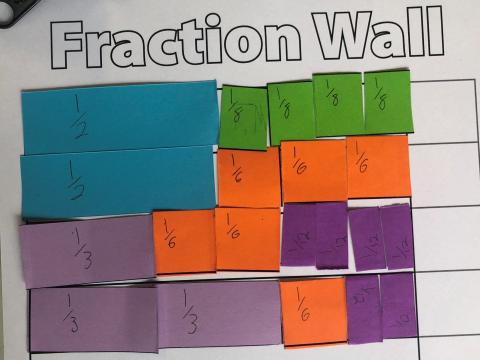
Impact and Benefits:
Figure 9 shows four tasks, including the initial baseline assessment. The blue series shows the percentage of students who arrived at least one correct solution. The green series shows evidence that students were revisiting their initial solutions using other strategies to check they were correct or checking in with other groups and adjusting. There was a steady increase in both skills over the course of these four tasks.
By explicitly teaching Polya's problem-solving process, the students cultivated valuable skills that extend beyond maths problems. Some of the key benefits observed were:
Mathematical Reasoning: Polya's process promotes the development of mathematical reasoning skills. Students analysed problems, explored different strategies, and apply logical thinking to arrive at solutions. These skills can enhance their overall mathematical proficiency.
Self-efficacy: Through problem-solving, students gained confidence in their ability to tackle problems. They become more self-reliant, taking ownership of their learning, and seeking solutions proactively.
Collaboration and Communication: The process encouraged collaboration and communication among students. They discussed problems, shared ideas, and considered multiple perspectives, students developed effective teamwork and interpersonal skills.
Metacognition: The reflective aspect of Polya's process fostered metacognitive skills, enabling students to monitor and regulate their thinking processes. They learned to identify their strengths and weaknesses, supporting continuous improvement and growth.
Overall using the 4 steps was a really effective and an explicit way to focus on developing the problem-solving skills of my Year 6 students.
This article was originally published for the Mathematical Association of Victoria's Prime Number.
References:
Barnes, A. (2021). Enjoyment in learning mathematics: Its role as a potential barrier to children’s perseverance in mathematical reasoning. Educational Studies in Mathematics , 106(1), 45–63. https://doi.org/10.1007/s10649-020-09992-x
Bicer, Ali, Yujin Lee, Celal Perihan, Mary M. Capraro, and Robert M. Capraro. ‘Considering Mathematical Creative Self-Efficacy with Problem Posing as a Measure of Mathematical Creativity’. Educational Studies in Mathematics 105, no. 3 (November 2020): 457–85. https://doi.org/10.1007/s10649-020-09995-8
Buckley, S., & Sullivan, P. (2023). Reframing anxiety and uncertainty in the mathematics classroom. Mathematics Education Research Journal , 35(S1), 157–170. https://doi.org/10.1007/s13394-021-00393-8
OECD (Ed.). (2014). Creative problem solving: Students’ skills in tackling real-life problems. OECD.
Pólya, G. (1988). How to solve it: A new aspect of mathematical method (2nd ed). Princeton university press.
Roche, A., Gervasoni, A., & Kalogeropoulos, P. (2023). Factors that promote interest and engagement in learning mathematics for low-achieving primary students across three learning settings. Mathematics Education Research Journal , 35(3), 525–556. https://doi.org/10.1007/s13394-021-00402-w

- Mathematics
- Reading and Writing
- Intervention
- Professional Learning
- Virtual Events
- What is Phonics?
- Teaching Grammar
- Vocabulary Games
- What is Virtual Learning?
- About Sadlier
- Find a Sales Representative
- International Distributors
- International Programs
- Online Catalogs
- Sadlier School Site Map
- Pricing & Ordering Information
- Sadlier’s W-9
- Sadlier’s Sole Source Letter
- Sadlier’s Credit Application
- Privacy Policy
- Return Policy
- Terms & Conditions
Sadlier's Math Blog

- Counting and Cardinality
- Operations and Algebraic Thinking
- Number and Operations in Base 10
- Measurement and Data
- Math Practices
- Number and Operations Fractions
- Statistics and Probability
- The Number System
- Ratios and Proportional Relationships
- Expressions and Equations
- MP1—Problem Solving
- MP2—Abstract <−>Quantitative
- MP3—Reasoning
- MP4—Modeling
- MP5—Using Tools
- MP6—Precision
- MP7—Structure
- MP8—Repeated Reasoning
- Kindergarten Math Activities
- First Grade Math Activities
- Second Grade Math Activities
- Third Grade Math Activities
- Fourth Grade Math Activities
- Fifth Grade Math Activities
- Sixth Grade Math Activities
- Seventh Grade Math Activities
- Eighth Grade Math Activities
- Professional Development
- Test-Taking Strategies
- Classroom Posters
- Writing In Mathematics
April 19, 2023 3-5-operations-and-algebraic-thinking , k-2-operations-and-algebraic-thinking , 6-8-expressions-and-equations
Polya’s problem-solving process: finding unknowns elementary & middle school, by: jeff todd.
In this article, we'll explore how a focus on finding “unknowns” in math will lead to active problem-solving strategies for Kindergarten to Grade 8 classrooms. Through the lens of George Polya and his four-step problem-solving heuristic, I will discuss how you can apply the concept of finding unknowns to your classroom. Plus, download my Finding Unknowns in Elementary and Middle School Math Classes Tip Sheet .
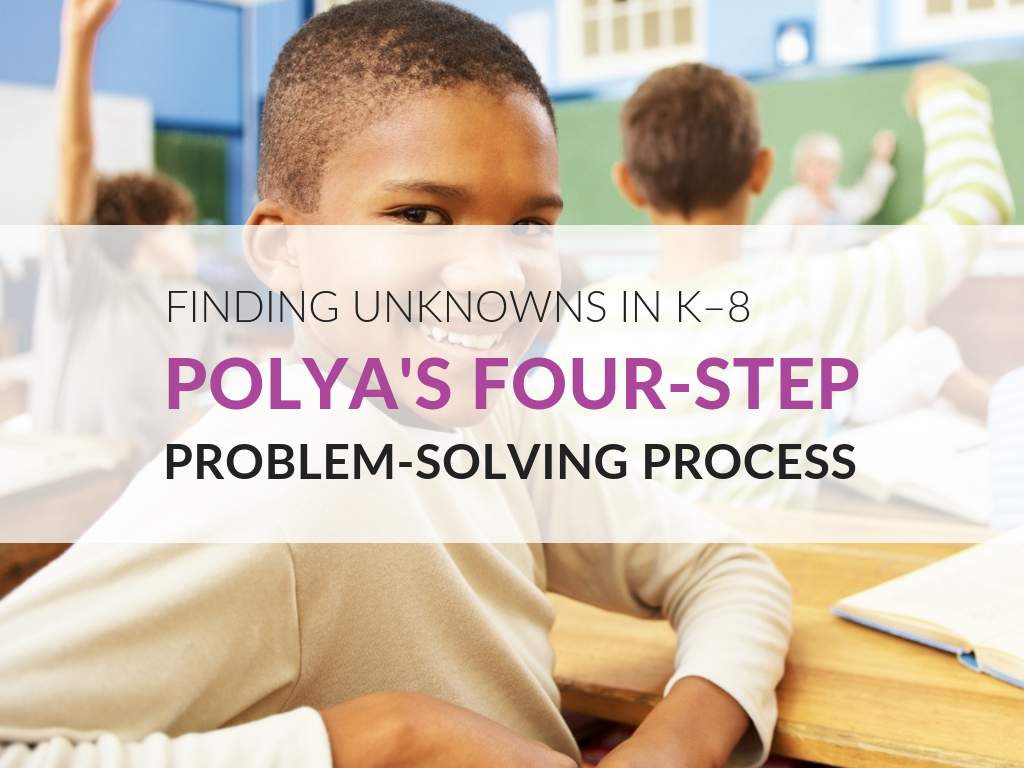
It is unfortunate that in the United States mathematics has a reputation for being dry and uninteresting. I hear this more from adults than I do from children—in fact, I find that children are naturally curious about how math works and how it relates to the world around them. It is from adults that they get the idea that math is dry, boring, and unrelated to their lives. Despite what children may or may not hear about math, I focus on making instruction exciting and showing my students that math applicable to their lives.
Problem solving is a fundamental means of developing students' mathematical knowledge and it also shows them that math concepts apply to real-world concepts.
Problem solving is one way I show my students that math relates to their lives! Problem solving is a fundamental means of developing students' mathematical knowledge and it also shows them that math concepts apply to real-world concepts.
Who Is George Polya?
George Polya was a European-born scholar and mathematician who moved to the U.S in 1940, to work at Stanford University. When considering the his classroom experience of teaching mathematics, he noticed that students were not presented with a view of mathematics that excited and energized them. I know that I have felt this way many times in my teaching career and have often asked: How can I make this more engaging and yet still maintain rigor?
Polya suggested that math should be presented in the light of being able to solve problems. His 1944 book, How to Solve It contains his famous four-step problem solving heuristic. Polya suggests that by presenting mathematical thinking as a way to find “unknowns,” it becomes more engaging for students.
He even goes as far as to say that his general four-step problem-solving heuristic can be applied to any field of human endeavor—to any opportunity where a problem exists.
Polya suggested that math should be presented in the light of being able to solve problems...that by presenting mathematical thinking as a way to find “unknowns,” it becomes more engaging for students.
Polya specifically wrote about problem-solving at the high school mathematics level. For those of us teaching students in the elementary and middle school levels, finding ways to apply Polya’s problem-solving process as he intended forces us to rethink the way we teach.
Particularly in the lower grade levels, finding “unknowns” can be relegated to prealgebra and algebra courses in the later grades. Nonetheless, today’s standards call for algebra and algebraic thinking at early grade levels. The download for today’s post presents one way you can find unknowns at each grade level.
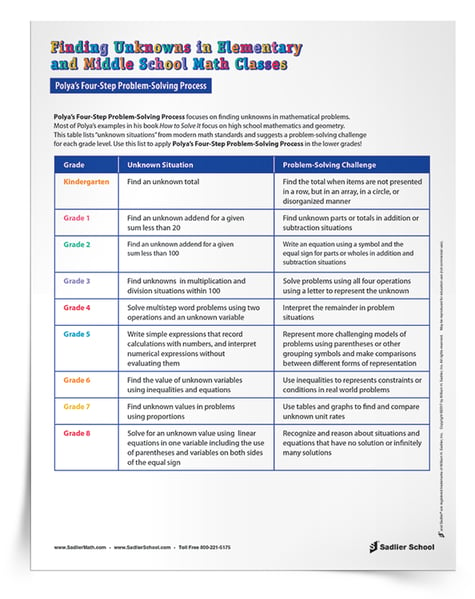
Presenting Mathematics As A Way To Find "Unknowns" In Real-Life Situations
I would like to share a conversation I had recently with my friend Stu. I have been spending my summers volunteering for a charitable organization in Central America that provides medical services for the poor, runs ESL classes, and operates a Pre-K to Grade 6 school. We were talking about the kind of professional development that I might provide the teachers, and he was intrigued by the thought that we could connect mathematical topics to real life. We specifically talked about the fact that he remembers little or nothing about how to find the area of a figure and never learned in school why it might be important to know about area. Math was presented to him as a set of rules and procedures rather than as a way to find unknowns in real-life situations.
That’s what I am talking about here, and it’s what I believe Polya was talking about. How can we create classrooms where students are able to use their mathematical knowledge to solve problems, whether real-life or purely mathematical?
As Polya noted, there are two ways that mathematics can be presented, either as deductive system of rules and procedures or as an inductive method of making mathematics. Both ways of thinking about mathematics have endured through the centuries, but at least in American education, there has been an emphasis on a procedural approach to math. Polya noticed this in the 1940s, and I think that although we have made progress, there is still an over-emphasis on skill and procedure at the expense of problem-solving and application.
I recently reread Polya’s book. I can’t say that it is an “easy” read, but I would say that it was valuable for me to revisit his own words in order to be sure I understood what he was advocating. As a result, I made the following outline of his problem-solving process and the questions he suggests we use with students.
Polya's Problem-Solving Process
1. understand the problem, and desiring the solution .
- Restate the problem
- Identify the principal parts of the problem
- Essential questions
- What is unknown?
- What data are available?
- What is the condition?
2. Devising a Problem-Solving Plan
- Look at the unknown and try to think of a familiar problem having the same or similar unknown
- Here is a problem related to yours and solved before. Can you use it?
- Can you restate the problem?
- Did you use all the data?
- Did you use the whole condition?
3. Carrying Out the Problem-Solving Plan
- Can you see that each step is correct?
- Can you prove that each step is correct?
4. Looking Back
- Can you check the result?
- Can you check the argument?
- Can you derive the result differently?
- Can you see the result in a glance?
- Can you use the result, or the method, for some other problem?
Polya's Suggestions For Helping Students Solve Problems
I also found four suggestions from Polya about what teachers can do to help students solve problems:
Suggestion One In order for students to understand the problem, the teacher must focus on fostering in students the desire to find a solution. Absent this motivation, it will always be a fight to get students to solve problems when they are not sure what to do.
Suggestion Two A second key feature of this first phase of problem-solving is giving students strategies forgetting acquainted with problems.
Suggestion Three Another suggestion is that teachers should help students learn strategies to be able to work toward a better understanding of any problem through experimentation.
Suggestion Four Finally, when students are not sure how to solve a problem, they need strategies to “hunt for the helpful idea.”
Whether you are thinking of problem-solving in a traditional sense (solving computational problems and geometric proofs, as illustrated in Polya’s book) or you are thinking of the kind of problem-solving students can do through STEAM activities, I can’t help but hear echoes of Polya in Standard for Math Practice 1: Make sense of problems and persevere in solving them.
Mathematically proficient students start by explaining to themselves the meaning of a problem and looking for entry points to its solution. They analyze givens, constraints, relationships, and goals. They make conjectures about the form and meaning of the solution and plan a solution pathway rather than simply jumping into a solution attempt. They consider analogous problems, and try special cases and simpler forms of the original problem in order to gain insight into its solution. They monitor and evaluate their progress and change course if necessary.
In Conclusion
We all know we should be fostering students’ problem-solving ability in our math classes. Polya’s focus on “finding unknowns” in math has wide applicability to problems whether they are purely mathematical or more general.
Grab my download and start applying Polya’s Four-Step Problem-Solving Process in the lower grades!

Intermediate Algebra Tutorial 8
- Use Polya's four step process to solve word problems involving numbers, percents, rectangles, supplementary angles, complementary angles, consecutive integers, and breaking even.
Whether you like it or not, whether you are going to be a mother, father, teacher, computer programmer, scientist, researcher, business owner, coach, mathematician, manager, doctor, lawyer, banker (the list can go on and on), problem solving is everywhere. Some people think that you either can do it or you can't. Contrary to that belief, it can be a learned trade. Even the best athletes and musicians had some coaching along the way and lots of practice. That's what it also takes to be good at problem solving.
George Polya , known as the father of modern problem solving, did extensive studies and wrote numerous mathematical papers and three books about problem solving. I'm going to show you his method of problem solving to help step you through these problems.
If you follow these steps, it will help you become more successful in the world of problem solving.
Polya created his famous four-step process for problem solving, which is used all over to aid people in problem solving:
Step 1: Understand the problem.
Step 2: Devise a plan (translate).
Step 3: Carry out the plan (solve).
Step 4: Look back (check and interpret).
Just read and translate it left to right to set up your equation
Since we are looking for a number, we will let
x = a number
*Get all the x terms on one side
*Inv. of sub. 2 is add 2
FINAL ANSWER: The number is 6.
We are looking for two numbers, and since we can write the one number in terms of another number, we will let
x = another number
ne number is 3 less than another number:
x - 3 = one number
*Inv. of sub 3 is add 3
*Inv. of mult. 2 is div. 2
FINAL ANSWER: One number is 90. Another number is 87.
When you are wanting to find the percentage of some number, remember that ‘of ’ represents multiplication - so you would multiply the percent (in decimal form) times the number you are taking the percent of.
We are looking for a number that is 45% of 125, we will let
x = the value we are looking for
FINAL ANSWER: The number is 56.25.
We are looking for how many students passed the last math test, we will let
x = number of students
FINAL ANSWER: 21 students passed the last math test.
We are looking for the price of the tv before they added the tax, we will let
x = price of the tv before tax was added.
*Inv of mult. 1.0825 is div. by 1.0825
FINAL ANSWER: The original price is $500.
Perimeter of a Rectangle = 2(length) + 2(width)
We are looking for the length and width of the rectangle. Since length can be written in terms of width, we will let
length is 1 inch more than 3 times the width:
1 + 3 w = length
*Inv. of add. 2 is sub. 2
*Inv. of mult. by 8 is div. by 8
FINAL ANSWER: Width is 3 inches. Length is 10 inches.
Complimentary angles sum up to be 90 degrees.
We are already given in the figure that
x = one angle
5 x = other angle
*Inv. of mult. by 6 is div. by 6
FINAL ANSWER: The two angles are 30 degrees and 150 degrees.
If we let x represent the first integer, how would we represent the second consecutive integer in terms of x ? Well if we look at 5, 6, and 7 - note that 6 is one more than 5, the first integer.
In general, we could represent the second consecutive integer by x + 1 . And what about the third consecutive integer.
Well, note how 7 is 2 more than 5. In general, we could represent the third consecutive integer as x + 2.
Consecutive EVEN integers are even integers that follow one another in order.
If we let x represent the first EVEN integer, how would we represent the second consecutive even integer in terms of x ? Note that 6 is two more than 4, the first even integer.
In general, we could represent the second consecutive EVEN integer by x + 2 .
And what about the third consecutive even integer? Well, note how 8 is 4 more than 4. In general, we could represent the third consecutive EVEN integer as x + 4.
Consecutive ODD integers are odd integers that follow one another in order.
If we let x represent the first ODD integer, how would we represent the second consecutive odd integer in terms of x ? Note that 7 is two more than 5, the first odd integer.
In general, we could represent the second consecutive ODD integer by x + 2.
And what about the third consecutive odd integer? Well, note how 9 is 4 more than 5. In general, we could represent the third consecutive ODD integer as x + 4.
Note that a common misconception is that because we want an odd number that we should not be adding a 2 which is an even number. Keep in mind that x is representing an ODD number and that the next odd number is 2 away, just like 7 is 2 away form 5, so we need to add 2 to the first odd number to get to the second consecutive odd number.
We are looking for 3 consecutive integers, we will let
x = 1st consecutive integer
x + 1 = 2nd consecutive integer
x + 2 = 3rd consecutive integer
*Inv. of mult. by 3 is div. by 3
FINAL ANSWER: The three consecutive integers are 85, 86, and 87.
We are looking for 3 EVEN consecutive integers, we will let
x = 1st consecutive even integer
x + 2 = 2nd consecutive even integer
x + 4 = 3rd consecutive even integer
*Inv. of add. 10 is sub. 10
FINAL ANSWER: The ages of the three sisters are 4, 6, and 8.
In the revenue equation, R is the amount of money the manufacturer makes on a product.
If a manufacturer wants to know how many items must be sold to break even, that can be found by setting the cost equal to the revenue.
We are looking for the number of cd’s needed to be sold to break even, we will let
*Inv. of mult. by 10 is div. by 10
FINAL ANSWER: 5 cd’s.
To get the most out of these, you should work the problem out on your own and then check your answer by clicking on the link for the answer/discussion for that problem . At the link you will find the answer as well as any steps that went into finding that answer.
Practice Problems 1a - 1g: Solve the word problem.
(answer/discussion to 1e)
http://www.purplemath.com/modules/translat.htm This webpage gives you the basics of problem solving and helps you with translating English into math.
http://www.purplemath.com/modules/numbprob.htm This webpage helps you with numeric and consecutive integer problems.
http://www.purplemath.com/modules/percntof.htm This webpage helps you with percent problems.
http://www.math.com/school/subject2/lessons/S2U1L3DP.html This website helps you with the basics of writing equations.
http://www.purplemath.com/modules/ageprobs.htm This webpage goes through examples of age problems, which are like the numeric problems found on this page.
Go to Get Help Outside the Classroom found in Tutorial 1: How to Succeed in a Math Class for some more suggestions.

Analysis of problem-solving skills with Polya's steps in solving numeracy problems in class VIII junior high school in terms of gender differences
- Article contents
- Figures & tables
- Supplementary Data
- Peer Review
- Reprints and Permissions
- Cite Icon Cite
- Search Site
Shafira Ramadhani , Adi Nurcahyo , Nuraini Kasman , Hardianti , Jamaluddin Ahmad; Analysis of problem-solving skills with Polya's steps in solving numeracy problems in class VIII junior high school in terms of gender differences. AIP Conf. Proc. 17 January 2024; 2926 (1): 020045. https://doi.org/10.1063/5.0183389
Download citation file:
- Ris (Zotero)
- Reference Manager
The purpose of the study is to describe students' problem-solving skills in solving numeracy problems in relation and function materials using Polya steps based on gender. Types of research using qualitative. Data collection techniques using written tests, interviews, and documentation. The subjects of this study were 30 class VIII students at SMP Negeri 2 Banyudono. Indicators of problem-solving skills based on Polya's four steps. The results of the study showed that female students were superior with an average score of 62.91 while male students with an average of 55.67. Problem-solving skills at the step of understanding the problem female students can write down information that is known and asked on the question even though it is not complete, male students mostly do not write down important information on the questions. In the second step, developing a plan, students can use important information on the questions to help solve problems, but there are still shortcomings. In the third step, implementing the plan students are able and able to answer the questions asked even though there are still shortcomings. The last step, re-examining students, there are still many who do not confirm whether the answer has answered the question on the question or not, but students can make conclusions about each question.
Sign in via your Institution
Citing articles via, publish with us - request a quote.

Sign up for alerts
- Online ISSN 1551-7616
- Print ISSN 0094-243X
- For Researchers
- For Librarians
- For Advertisers
- Our Publishing Partners
- Physics Today
- Conference Proceedings
- Special Topics

pubs.aip.org
- Privacy Policy
- Terms of Use
Connect with AIP Publishing
This feature is available to subscribers only.
Sign In or Create an Account
- Primary Hub
- Art & Design
- Design & Technology
- Health & Wellbeing
- Secondary Hub
- Citizenship
- Primary CPD
- Secondary CPD
- Book Awards
- All Products
- Primary Products
- Secondary Products
- School Trips
- Trip Directory
- Trips by Subject
- Trips by Type
- Trips by Region
- Submit a Trip Venue
Trending stories

Top results

- Ks2 Maths Polya Problem Solving
KS2 maths – Polya’s problem-solving

From groans and panic to calm and curiosity – how Claire Coolin made systematic maths lessons less scary…

Are you met with groans when you utter the term ‘problem-solving’ to your class?
We all agree that it’s is an important aspect of the curriculum and indeed a life skill, but yet remains a divisive topic of conversation with pupils, parents and colleagues.
So, what is the problem with problem-solving?
My Year 5 class were high-achieving. In general, they enjoyed maths but when it came to problem-solving many of them froze.
They showed disinterest, nervousness and confusion, saying things like, “The information is hard to process,” and “I couldn’t understand the information as it was just a block of words”.
Interestingly, pupils found the lessons boring when the problems that they solved followed the same routine and pattern, and didn’t provide a level of challenge, interest or excitement.
These routine problems ‘took the fun’ out of maths for them, and while using skills such as addition, subtraction , and so on are all part and parcel of problem-solving, is this what we are trying to achieve here?
Routine and non-routine problems
Problem-solving can show an in-depth understanding of mathematical concepts where pupils are required to manipulate numbers in order to get to an answer.
However, while routine problems might be easier for the children to solve, they are not aligned to maths in real life .
We don’t live our adult lives practising budgeting for the weekly supermarket shop from Monday to Thursday, with the real deal happening on Friday. Rather, real-life problems can often be spontaneous, unexpected and at first have no obvious solution.
Should we therefore be teaching pupils what to do with the unexpected? Should we be equipping them with the skills to solve non-routine problems? I think the answer is, yes, most definitely.
Polya’s problem-solving
So what can be done? Is it enough to tell the children in your class to highlight the important words in the problem ?
While this might have helped a few of my pupils to see a way forward, for many this just became a colouring exercise with an impressive array of fancy highlighters on show.
And so I began an action research project to find answers. After poring over many academic articles, I came across Polya’s problem-solving cycle : a cyclical four-step process that could be used to solve any problem, in maths or otherwise. The steps are:
- Understanding the problem
- Devising a plan
- Carrying out the plan
- Looking back and reflecting
Polya’s process was something I wanted to introduce to my class, and so I taught this way of thinking about a problem over a term. The results were surprising and long-lasting, with four key takeaway points.
I found that the cycle:
Developed time management skills and enhanced focus
Polya’s cycle automatically forced students to work through each phase in turn, slowing them down and therefore helping them explore the problem with a more thoughtful and connected approach.
Instead of jumping straight into the doing, the children took time to think about their understanding of what was being asked, and would often get out a dictionary to look up a word they didn’t know the meaning of, or on one occasion, a child even dusted off the ‘never-really-used-before-but-every-class-has-one’ maths dictionary to look up the meaning of a mathematical term.
Equipped all students with a strategy for tackling any maths problem
When talking to a group of pupils in my class about problem-solving, I recall them saying, “I can’t work out if I should multiply or add or subtract or whatever.”
This is true for many students and can lead to them freezing, or in some cases, frantically adding and subtracting numbers – essentially jumping straight into phase three.
They needed a strategy. Using the problem-solving steps gave my class a framework, allowing them to think in a logical way.
Straight away, students unfroze, the manic scribbling stopped, and they started from a phase one and worked through the problem more systematically.
Allowed pupils to see the link between maths and the real world
When I asked my class why they thought we were learning about problem-solving, I was met with answers about becoming better at maths.
But after using Polya’s steps, the children began to see how the skills in solving maths problems are the same ones used in solving real-world problems.
For example, they realised that if a maths problem can be divided into chunks, then so could any problem.
One sunny afternoon, a couple of students came to me to help solve their playground argument. You can imagine my utter surprise when one of the students said, “I think first we need to understand why we have fallen out then we can come up with a plan to put it right.” Real life problem-solving in action!
Equipped students with the necessary tools to engage with challenge
Having challenge in any subject is important, but having the right level of challenge is even more so.
Routine problems can remove that challenge for many, and one of my pupils commented that, “You shouldn’t do lots of the same as it gets too easy. You don’t want to spoil it by knowing all the answers.”
Using Polya’s problem-solving steps with non-routine problems gives the more able pupils enhanced scope and freedom to try out and manipulate numbers in different ways, while giving that scaffolding to support the less able in the class.
So, what now?
What have I learned from this experience? Well, with more than 10 years teaching under my belt, this action research brought me back to my roots.
I started from scratch with something and didn’t rely on my tried-and-tested resources. I had a chance to listen to my pupils and in doing so stumbled onto a way of thinking that works not just for a maths problem, but for all problems.
The steps have since become a classroom philosophy, and I use the vocabulary of the process daily. Trying something new can pay off!
How to introduce Polya’s process
- Talk about the cycle and what each phase means. Take note that it’s like a roundabout, which means you can get off at any stop and go back if necessary. E.g. If you’re carrying out your plan (phase three) but it’s not working, you can go back to phase one: understanding the problem.
- Use subheadings. I wanted the students to really spend time thinking about each phase, so I made a very simple Performa with each phase sub-headed. The students were required to write within each subheading.
- Model how to do it. Using different non-routine problems, I modelled how I would use the problem-solving phases. I then built up to working on problems as a class, and finally asked pupils to work in pairs to solve problems using the steps.
- Make it part of your classroom vocabulary. To embed the process in my class, the language didn’t just come out when doing maths problems, but was used in other subjects and day-to-day school life.
Claire Coolin conducted this research project while teaching Year 5 at Oxford High Prep School, GDST with the Global Action Research Collaborative, ICGS. From September 2022 she will be a maths specialist teacher and PSHE head of department at Summer Fields School, Oxford.
Sign up to our newsletter
You'll also receive regular updates from Teachwire with free lesson plans, great new teaching ideas, offers and more. (You can unsubscribe at any time.)
Which sectors are you interested in?
Early Years
Thank you for signing up to our emails!
You might also be interested in...
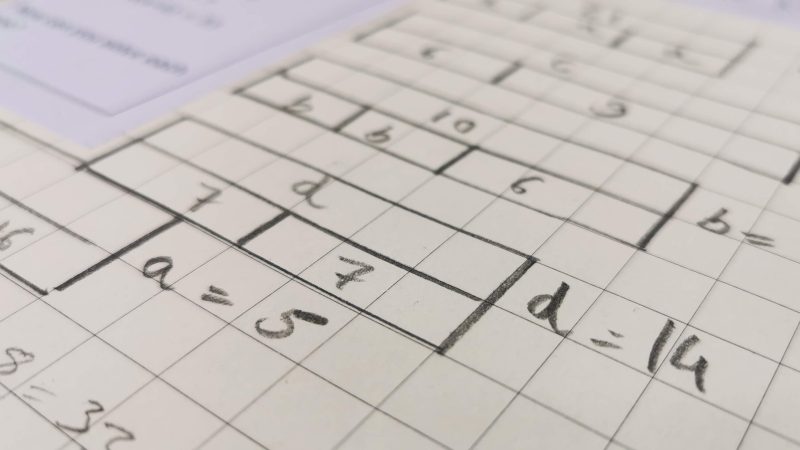
Why join Teachwire?
Get what you need to become a better teacher with unlimited access to exclusive free classroom resources and expert CPD downloads.
Exclusive classroom resource downloads
Free worksheets and lesson plans
CPD downloads, written by experts
Resource packs to supercharge your planning
Special web-only magazine editions
Educational podcasts & resources
Access to free literacy webinars
Newsletters and offers
Create free account
By signing up you agree to our terms and conditions and privacy policy .
Already have an account? Log in here
Thanks, you're almost there
To help us show you teaching resources, downloads and more you’ll love, complete your profile below.
Welcome to Teachwire!
Set up your account.
Lorem ipsum dolor sit amet consectetur adipisicing elit. Commodi nulla quos inventore beatae tenetur.
I would like to receive regular updates from Teachwire with free lesson plans, great new teaching ideas, offers and more. (You can unsubscribe at any time.)
Log in to Teachwire
Not registered with Teachwire? Sign up for free
Reset Password
Remembered your password? Login here


- school Campus Bookshelves
- menu_book Bookshelves
- perm_media Learning Objects
- login Login
- how_to_reg Request Instructor Account
- hub Instructor Commons
- Download Page (PDF)
- Download Full Book (PDF)
- Periodic Table
- Physics Constants
- Scientific Calculator
- Reference & Cite
- Tools expand_more
- Readability
selected template will load here
This action is not available.

2.1: George Polya's Four Step Problem Solving Process
- Last updated
- Save as PDF
- Page ID 132871
Step 1: Understand the Problem
- Do you understand all the words?
- Can you restate the problem in your own words?
- Do you know what is given?
- Do you know what the goal is?
- Is there enough information?
- Is there extraneous information?
- Is this problem similar to another problem you have solved?
Step 2: Devise a Plan: Below are some strategies one might use to solve a problem. Can one (or more) of the following strategies be used? (A strategy is defined as an artful means to an end.)

IMAGES
VIDEO
COMMENTS
Polya's Problem Solving Techniques In 1945 George Polya published the book How To Solve It which quickly became his most prized publication. It sold over one million copies and has been translated ... This step is usually easier than devising the plan. In general, all you need is care and patience, given that you have the necessary skills ...
10: Problem Solving Logic Packet 10.1: George Polya's Four Step Problem Solving Process Expand/collapse global location
The first step of Polya's problem-solving process emphasises the importance of ensuring you thoroughly comprehend the problem. In this step, students learn to read and analyse the problem statement, identify the key information, and clarify any uncertainties. This process encourages critical thinking (Bicer et al., 2020) as students develop the ...
Polya's 4-Step Process. George Polya was a mathematician in the 1940s. He devised a systematic process for solving problems that is now referred to by his name: the Polya 4-Step Problem-Solving ...
Step 1: Understand the problem. It would seem unnecessary to state this obvious advice, but yet in my years of teaching, I have seen many students try to solve a problem before they completely understand it. The techniques that we will explain shortly will help you to avoid this critical mistake. Step 2: Devise a plan.
The four steps of the Polya method are as follows: Understand the problem. Devise a plan. Carry out the plan. Evaluate the solution. Let's take a closer look at each step. Step 1: Understand the ...
Polya specifically wrote about problem-solving at the high school mathematics level. For those of us teaching students in the elementary and middle school levels, finding ways to apply Polya's problem-solving process as he intended forces us to rethink the way we teach. Particularly in the lower grade levels, finding "unknowns" can be ...
Polya's four steps to solving a problem. George Polya (1887-1985), a Hungarian mathematician, wrote "How to solve it." for high school students in 1957. ... Design a plan for solving the problem: In essence, decide how you are going to work on the problem. This involves making some choices about what strategies to use.
Polya's Four Phases of Problem Solving The following comes from the famous book by George Polya called How to Solve It. 1. Understanding the Problem. ... Carrying out your plan of the solution, check each step. Can you see clearly that the step is correct? Can you prove that it is correct? 4. Looking Back. Examine the solution obtained.
To begin this task, we now discuss a framework for thinking about problem solving: Polya's four-step approach to problem solving. Polya's four-step approach to problem solving 1. Preparation: Understand the problem Learn the necessary underlying mathematical concepts Consider the terminology and notation used in the problem: 1.
Math in the Modern World Playlist: https://www.youtube.com/watch?v=vb-hDOm3GzU&list=PLbZl6MGLeYnsoaxa2L-xouDPHcoe9z23x&index=3A more logical answer to 13:36 ...
The following formula will come in handy for solving example 6: Perimeter of a Rectangle = 2 (length) + 2 (width) Example 6 : In a blueprint of a rectangular room, the length is 1 inch more than 3 times the width. Find the dimensions if the perimeter is to be 26 inches. Step 1: Understand the problem.
Explanation of Polya's Four Step problem solving technique. The four steps are explained in simple terms with an example of applying Polya's method.
In his book "How To Solve It," Polya provided four fundamental steps that serve as a compass for handling mathematical challenges. Understand the problem. Devise a Plan. Carry out the Plan ...
1. a) Act out the following: There are five people in a group and each shakes hands with every person. How many handshakes take place in a group? b) Draw/diagram what took place and write down what each part of your diagrams represents. c) List the number of handshakes for groups of 5, 6, and 7. 2. a) Solve the following problem in your head ...
The purpose of the study is to describe students' problem-solving skills in solving numeracy problems in relation and function materials using Polya steps based on gender. Types of research using qualitative.
2.3.1: George Polya's Four Step Problem Solving Process - Mathematics LibreTexts. school Campus Bookshelves. menu_book Bookshelves. perm_media Learning Objects. login Login. how_to_reg Request Instructor Account. hub Instructor Commons.
The steps are: Understanding the problem. Devising a plan. Carrying out the plan. Looking back and reflecting. Polya's process was something I wanted to introduce to my class, and so I taught this way of thinking about a problem over a term. The results were surprising and long-lasting, with four key takeaway points.
Step 3: Carry Out the Plan. After devising a plan, the next step is to carry it out. This involves following the plan you've created and solving the problem step by step. It's important to be ...
problems of sequences and series based on problem-solving steps of Polya. Method The method used in this study is a qualitative method with a qualitative descriptive approach. The study was conducted on February 24, 2022. Of the 21 students of class XI-B SMA Plus Ar-Rahmat Bojonegoro who were
Step 2: Devise a Plan: Below are some strategies one might use to solve a problem. Can one (or more) of the following strategies be used? (A strategy is defined as an artful means to an end.) 1. Guess and test.
Polya's Problem Solving Techniques - In 1945 George Polya published the book How To Solve It which quickly became his most prized publication. - It sold over one million copies and has been translated into 17 languages. - In this book he identifies four basic principles of problem solving. 1. Understand the problem 2. Devise a plan 3.